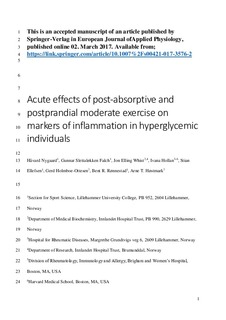| dc.contributor.author | Nygård, Håvard | |
| dc.contributor.author | Slettaløkken, Gunnar | |
| dc.contributor.author | Whist, Jon Elling | |
| dc.contributor.author | Hollan, Ivana | |
| dc.contributor.author | Ellefsen, Stian | |
| dc.contributor.author | Holmboe-Ottesen, Gerd | |
| dc.contributor.author | Rønnestad, Bent | |
| dc.contributor.author | Høstmark, Arne Torbjørn | |
| dc.date.accessioned | 2018-10-10T12:05:05Z | |
| dc.date.available | 2018-10-10T12:05:05Z | |
| dc.date.created | 2017-04-07T11:04:06Z | |
| dc.date.issued | 2017 | |
| dc.identifier.citation | European Journal of Applied Physiology. 2017, 117 (4), 1-8. | |
| dc.identifier.issn | 1439-6319 | |
| dc.identifier.uri | http://hdl.handle.net/11250/2567433 | |
| dc.description.abstract | Abstract Purpose Systemic inflammation is involved in the development of several diseases, including cardiovascular disease and type 2 diabetes. It is known that vigorous exercise affects systemic inflammation, but less is known about exercise at lower intensities. Hyperglycemia can also entail pro-inflammatory responses; however, postprandial hyperglycemia is blunted if the meal is followed by exercise. Hypotheses were: (1) moderate physical exercise acutely affects levels of C-reactive protein (CRP) and serum soluble vascular cell adhesion molecule 1 (sVCAM-1) in hyperglycemic individuals and (2) the effect depends on whether the activity is performed in a post-absorptive or postprandial state. Methods Twelve participants diagnosed with hyperglycemia, but not using anti-diabetic medication, underwent three test days in a randomized cross-over study; 1 control day without exercise, 1 day with 60 min of treadmill walking ending 30 min before breakfast, and 1 day with an identical bout of activity 30 min after the start of breakfast. Food intake was strictly standardized and venous blood for CRP, and sVCAM-1 analysis was sampled at standardized timepoints during the first 3.5 h after breakfast and once 24 h later. Results Merged data from the two exercise days showed that sVCAM-1 increased from baseline (4 ± 16 ng/mL) compared to the control condition (−28 ± 47 ng/mL, ES = 0.7, p = 0.024). There was no statistically significant difference in changes in sVCAM-1 levels between the two exercise test days. Exercise did not affect CRP values. Conclusion Moderate exercise increases sVCAM-1 in hyperglycemic individuals, whereas it does not affect CRP. | en |
| dc.language.iso | eng | |
| dc.rights | Navngivelse-Ikkekommersiell-DelPåSammeVilkår 4.0 Internasjonal | * |
| dc.rights.uri | http://creativecommons.org/licenses/by-nc-sa/4.0/deed.no | * |
| dc.subject | Atherosclerosis; | en |
| dc.subject | Blood; | en |
| dc.subject | CRP; | en |
| dc.subject | Life style; | en |
| dc.subject | Physical activity; | en |
| dc.subject | sVCAM-1; | en |
| dc.title | Acute effects of post-absorptive and postprandial moderate exercise on markers of inflammation in hyperglycemic individuals | en |
| dc.type | Peer reviewed | en |
| dc.type | Journal article | en |
| dc.description.version | acceptedVersion | |
| dc.rights.holder | © Springer-Verlag Berlin Heidelberg 2017. | nb_NO |
| dc.source.pagenumber | 1-8 | nb_NO |
| dc.source.volume | 117 | nb_NO |
| dc.source.journal | European Journal of Applied Physiology | nb_NO |
| dc.source.issue | 4 | nb_NO |
| dc.identifier.doi | 10.1007/s00421-017-3576-2 | |
| dc.identifier.cristin | 1464311 | |
| cristin.unitcode | 1991,7,0,0 | |
| cristin.unitcode | 1991,1,2,0 | |
| cristin.unitname | Div Medisinsk service | |
| cristin.unitname | Avd Forskning | |
| cristin.ispublished | true | |
| cristin.fulltext | postprint | |
| cristin.qualitycode | 1 | |

